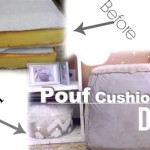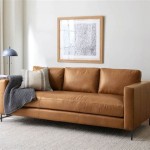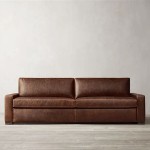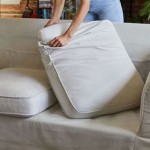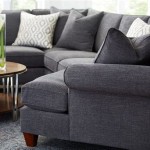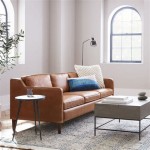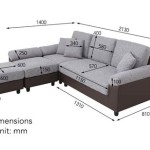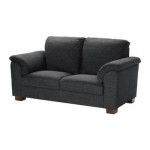Cushion Foam for Sofas: A Comprehensive Guide
Sofa cushions are integral to comfort and aesthetics. The foam within these cushions plays a crucial role in determining the sofa's longevity, support, and overall feel. Understanding the different types of cushion foam available can help consumers make informed decisions when purchasing a new sofa or replacing existing cushions.
Key Considerations When Choosing Cushion Foam
Several factors influence the ideal cushion foam selection. These considerations contribute to the overall comfort and durability of the sofa:
*Density:
Foam density refers to the weight of the foam per cubic foot. Higher density generally indicates a more durable and supportive cushion. *Indentation Load Deflection (ILD):
ILD measures the foam's firmness. A higher ILD indicates a firmer foam. *Resilience:
Resilience refers to the foam's ability to bounce back after compression. High resilience equates to a longer lifespan. *Fire Retardancy:
Regulations often require furniture foam to meet specific fire safety standards.Types of Cushion Foam
Various foam types cater to different needs and preferences. Each type offers unique properties that contribute to the overall comfort and durability of the sofa:
Polyurethane Foam
Polyurethane foam, often referred to as poly foam, is the most common type used in sofa cushions. It is cost-effective and offers a good balance of comfort and support.
High-Resiliency Polyurethane Foam (HR Foam)
HR foam is a more durable and resilient version of standard polyurethane foam. It offers enhanced support and a longer lifespan, making it a popular choice for high-traffic areas.
Memory Foam
Memory foam conforms to the body's shape, providing excellent pressure relief and support. It is known for its ability to slowly return to its original shape after compression.
Latex Foam
Latex foam is a natural and durable option derived from rubber trees. It is known for its breathability, resilience, and resistance to dust mites and mold.
Foam Blends
Manufacturers often combine different foam types to achieve specific performance characteristics. For instance, a blend of memory foam and poly foam can provide both comfort and support.
Understanding Foam Density and ILD
Density and ILD are crucial factors when selecting cushion foam. Understanding their relationship contributes to selecting the appropriate foam for specific needs:
Foam Density
Foam density is typically measured in pounds per cubic foot (PCF). A higher density generally indicates a more durable and supportive cushion. Common densities for sofa cushions range from 1.5 PCF to 2.5 PCF.
*Low-Density Foam (1.5-1.8 PCF):
Suitable for back cushions or decorative pillows, offering soft support. *Medium-Density Foam (1.8-2.2 PCF):
Provides a balance of comfort and support, ideal for most sofa applications. *High-Density Foam (2.2+ PCF):
Offers superior support and durability, suitable for high-traffic areas and individuals requiring extra support.Indentation Load Deflection (ILD)
ILD measures the force required to indent a foam sample by 25%. It indicates the firmness of the foam. A higher ILD represents a firmer foam. ILD ratings typically range from 12 to 50.
*Soft (12-25 ILD):
Provides a plush and comfortable feel, ideal for back cushions. *Medium (25-35 ILD):
Offers a balance of comfort and support, suitable for most seating applications. *Firm (35-50 ILD):
Provides firm support, suitable for individuals who prefer a more supportive seating experience.Choosing the Right Cushion Foam
Selecting the appropriate cushion foam depends on individual preferences and intended use. Factors like sleeping habits, body weight, and the sofa's primary function (e.g., lounging, formal seating) influence the optimal choice.
Consider Your Sleeping Position
Different sleeping positions require varying levels of support. Side sleepers often benefit from softer foams that contour to the body, while back and stomach sleepers may prefer firmer foams for better spinal alignment.
Factor in Body Weight
Individuals with higher body weights generally require higher-density foams for adequate support and to prevent premature wear and tear.
Assess the Sofa's Primary Function
Sofas used primarily for lounging may benefit from softer, more comfortable foams, while sofas intended for formal seating may benefit from firmer, more supportive foams.
Maintaining Cushion Foam
Proper maintenance can extend the lifespan of sofa cushions. Regular fluffing and rotation can help prevent uneven wear and maintain the foam's shape and resilience.
Fluffing and Rotating Cushions
Regularly fluffing and rotating cushions helps distribute wear evenly and prevent indentations from forming. Flipping cushions periodically ensures both sides receive equal use.
Cleaning and Protecting Cushions
Following manufacturer guidelines for cleaning and protecting cushions is crucial. Using appropriate cleaning products and protecting cushions from spills and direct sunlight can help preserve their appearance and lifespan.

High Density Upholstery Foam Seat Sofa Cushion Replacement Sheets Padding Com

Couch Cushion Foam Solutions

4 Secrets To Finding Upholstery Foam A Erfly House

Cushions Options The Leather Sofa Company

Cushion Pittsburgh Pa Blawnox Upholstery Custom

Rectangular Replacement Sofa Cushion

Foam Cushion 6 T X 24 W 80 L 1536 Medium Firm Sofa Seat Replacement Upholstery Slab Padding Com

Replacement Seats And Cushions Foam

Sofa Cushions Guide Which Foam Type Is Best Living Spaces

Sit Better With Replacement Foam Sofa Cushions Foamite

